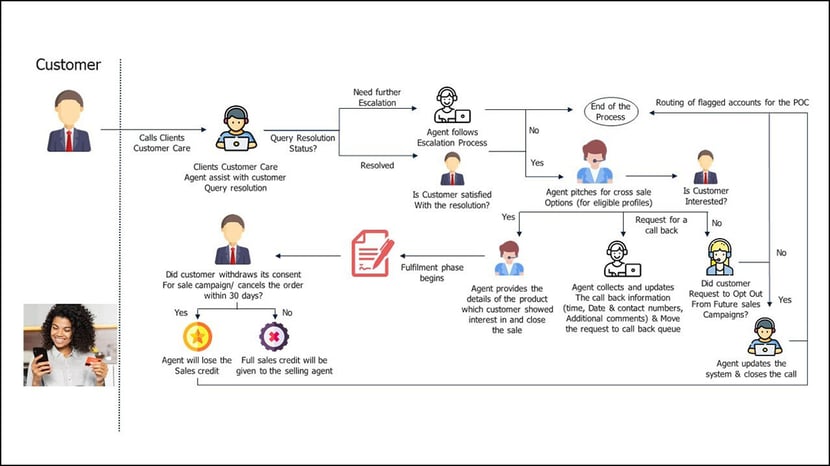In the last piece of Cross-selling in the CX environment, we gave an insight into what are the factors to be considered, the parameters, and essentially the approach of Coforge BPS.
Consumers now have many options and find it easier to buy goods and services in the digital era. While brand loyalty continues to exist, if a customer has a negative experience, they will quickly switch to another with the myriad options available at their disposal.
Therefore the goal of cross-selling is to increase the value of each customer relationship by encouraging them to purchase complementary or related products or services. It is an important strategy for businesses to maximize their revenue and enhance customer satisfaction.
Upselling and cross-selling – 42%, customer retention - 33%, and customer satisfaction - 32%, are the top three reasons businesses actively manage and invest in CX, according to SuperOffice Survey.
As 2023 is about to conclude, the strategies of customer retention across several industries continue to change. The approach to customers is also evolving to meet expectations while delivering quality products and services.
In this piece, you will be taken through the journey of one of our clients and how cross-selling in the CX environment takes place in real time.
Cross-selling for Issuer of Top 5 Debit Cards in the U.S.
We collaborated with one of the world's leading prepaid debit card companies, known for powering major payment platforms like Apple Pay Cash and Uber. They wanted to boost product usage across customer segments through personalized cross-selling.
Their primary challenge was to enhance the usage of their various products across all customer segments. To achieve this, they sought to implement tailored cross-selling strategies, taking into account each customer's likelihood to respond. Their goal was to create a personalized approach for their customers, refine their operational model, and continuously improve the overall process.
In response to their challenge, we proposed the development of a highly effective inbound cross-selling channel, harnessing the power of advanced data analytics and optimizing operational processes.
Approach to Cross-selling
Our generic approach to project management of cross-sell campaign solutions is listed below, followed by the specific solution that was offered to them:
- Define key activities for the Campaign
- Finalize POC (Proof of Concept) guidelines and success criterion to validate
- Identify resource requirements for both POC and Cross Sell Campaign
- Finalize assumptions and Business Case
- Get executive approval
- Launch POC and validate against success criterion
- Launch Cross Sell Campaign
- The value we added was in operationalizing the approach and ensuring specific measurable outcomes.
Operationalizing the approach
Since the solution required for them needed to increase cross-selling in specific areas, based on consumer response, as well as seek to further refine and improve, we focused on three main strategies:
- Data analytics to benchmark and improve the campaigns
- Leverage speech analytics to improvise scripts
- Refresher and ongoing training for new campaigns, and to strengthen product knowledge and improvise sales techniques

- Phase I – Discovery: The discovery phase was primarily a deep dive assessment to understand multiple input points
- Phase II – Detailed Design: The design phase used tools and techniques relevant to the solutions requested by the customer and to the inputs available from the discovery phase
- Phase III – The Launch: The launch phase goals had to include a successful POC and a full-scale rollout followed by a structure for expansion and continuous improvement
Our Proposed Solution for Cross-selling
The specific solution for the financial services provider customer had to ensure that it met their requirements of cross-selling across all their products and services for the current situation, as well as allowing them the framework to scale up in terms of newer products and the profile of future customers they may sign up.
The solution we implemented focused on 3 key aspects:
- Creation of a Sales Model that was based on a scoring criterion customized based on the customer’s environment
- Creation of Sales Scripts based on different unique selling propositions that they wanted to offer to their customer – in their case:
- Savings for their customer
- Security
- Convenience
- Scrubbing of all accounts to flag accounts eligible for cross-selling based on scoring
The basic workflow has been shown here. The flow shows cross-selling comes into play only after customer query resolution, and the ‘end of the processes' just indicates the end of the cross-selling process, not the end of the customer resolution.

Key Enablers to the solution
Several tools are typically available for a cross-sell solution – we chose the ones most appropriate to the requirement, the state of the customer’s processes and organization structure, as well as their appetite for change management and investments.
Below, we have outlined the specifics proposed for each of the above areas:
- Data and Analytics
- Create a Sales Model/ Eligibility and Propensity
- Daily scrubbing to flag accounts eligible for sales offers
- Identification of eligible product-based customer profile
- Optimization of Sales effort. Rank basis probability to convert & profitability to maximize AHT (Average Handling Time) investment
- Success Criterion measurement
- Contact Center and Sales COE
- Business Case / Impact Analysis
- Establish governance: Resource Requirements, Scorecards, Training, and Sales Scripts etc.
- Launch POC and Measure POC success
- Feedback and Coaching
- Program Expansion
- Contact Center Technology
- Assessment of technology needs
- Model design based on eligibility and propensity models
- Campaign setup (Infrastructure, Technology, etc.)
- Implementation plan
- Reporting and Dashboards
There was a time when customer experience was one aspect of an organization’s operational and marketing strategy. However, the world is rapidly changing. Today customer experience determines whether your organization will succeed or fail. To succeed in your CX efforts, you must start moving from a product-centric to
.jpeg?width=1813&height=490&upsize=true&upscale=true&name=Artefact%202%20(9).jpeg)


